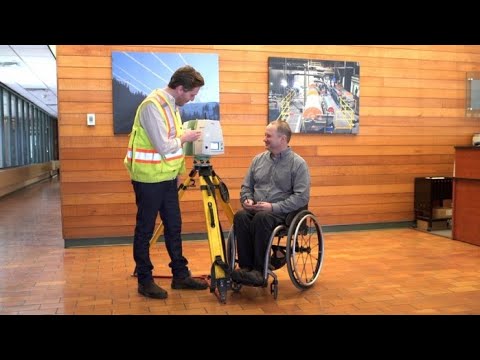Career Overview
Drafting technologists and technicians prepare engineering designs, drawings and related technical information.
Drafting technologists and technicians work for:
- Consulting and construction companies
- Utility, resource and manufacturing companies
- All levels of government
- A wide range of other establishments
They work within multidisciplinary engineering teams or in support of engineers, architects or industrial designers, or they may work independently.
Job Titles
Duties
Drafting technologists:
- Develop and prepare engineering designs and drawings from preliminary concepts, sketches, engineering calculations, specification sheets and other data
- Operate computer-assisted design (CAD) and drafting workstations
- Develop and prepare design sketches
- Complete documentation packages and produce drawing sets
- Verify that design drawings conform to specifications and design data
- Write technical reports
- Prepare contracts and tender documents
- Prepare construction specifications, costs and material estimates
- Supervise and train other technologists, technicians and drafters
Drafting technicians:
- Develop and prepare engineering drawings, plans, diagrams or layouts from sketches
- Operate computer-assisted drafting equipment or a conventional drafting station
Earnings
Earnings is income that workers receive in exchange for their labour. Depending on the type of employment, earnings can be in the form of wages (hourly), salaries (fixed monthly or annual) or self-employed earnings.
Work Environment
# Workers Employed
3,935% Employed Full Time
70%Work in this occupation is typically performed in a structured environment, such as an office.
Career Pathways
Senior and supervisory drafting and design technology workers require experience. Nevertheless, mobility is possible to civil, mechanical, electrical or other engineering design technologies through educational or work specialization.
Occupational Interests
It’s important to understand what kinds of occupations align with your interests.
For more about occupational interests visit Skills for the Future Workforce > Characteristics.
Here are the top occupational interest(s) for this career profile:
Education, Training and Skills
- Completion of secondary school is usually required
- Completion of a two- to three-year college program in engineering design and drafting technology or in a related field is usually required for drafting and design technologists
- Completion of a one- to two-year college program in drafting
or
Completion of a three- to four-year apprenticeship program
or
Four to five years of related experience plus completion of college or industry courses in drafting are usually required for drafting technicians - Trade certification for draftspersons is available, but voluntary in Ontario
- Certification in engineering design and drafting technology or in a related field through provincial associations of engineering/applied science technologists and technicians may be required by employers
- A period of supervised work experience, usually two years, is required before certification
Education programs in B.C.

Top Skills
Every job calls for a certain set of skills. Knowing those skills is the first step in finding a good career fit.
Here, you will find the 10 most relevant workplace skills. Some are more important to achieving success in a certain career than others. These skills may come naturally to you or you may need to gain them through education, training and experience.
See the list of work-related skills below, ranked in order of importance for this career. Check out the list and see if this career matches your skills—take that first step!
Understanding written sentences and paragraphs in work-related documents.
Using logic and reasoning to identify the strengths and weaknesses of alternative solutions, conclusions or approaches to problems.
Giving full attention to what other people are saying, taking time to understand the points being made, asking questions as appropriate, and not interrupting at inappropriate times.
Being able to solve novel, ill-defined problems in complex, real-world settings.
Understanding how new information could be used to solve current and future problems in making decisions.
Communicating effectively in writing as appropriate for the needs of the audience.
Considering the relative costs and benefits of potential actions to choose the most appropriate one.
Talking to others to share information effectively.
Determining how a system should work and how changes in conditions, operations and the environment will affect outcomes.
Using mathematics to solve problems.
Labour Market Statistics
Discover data, facts and information that have been gathered and analyzed. Learn about the characteristics of the economy and labour market in B.C.
Employment
Find out about employment types and trends by region and industry.
Employment
3,935Employment by Region







| Region | Employment | % Employment of this Occupation |
|---|---|---|
| Cariboo | 70 | 1.8% |
| Kootenay | 95 | 2.4% |
| Mainland/Southwest | 2,770 | 70.4% |
| North Coast and Nechako | 20 | 0.5% |
| Northeast | 35 | 0.9% |
| Thompson-Okanagan | 430 | 10.9% |
| Vancouver Island/Coast | 515 | 13.1% |
Labour Market Outlook
The B.C. Labour Market Outlook is a 10-year forecast of the expected supply and demand for labour in the province. It’s usually updated every year. The purpose is to provide British Columbians with the knowledge to make informed decisions on careers, skills training, education and hiring.
Forecasted Job Openings (2025-2035)
1,650Forecasted Job Openings
Forecasted Employment Growth Rate
Composition of Job Openings
Job Openings by Region (2025-2035)







| Region | Job Openings | Avg. Annual Employment Growth |
|---|---|---|
| Cariboo | 0 | -1.0% |
| Kootenay | 40 | 0.7% |
| Mainland/Southwest | 1,130 | 1.4% |
| North Coast and Nechako | Not available | Not available |
| Northeast | 10 | 1.4% |
| Thompson-Okanagan | 160 | 0.7% |
| Vancouver Island/Coast | 310 | 1.8% |
Industry Highlights
Learn about the opportunities in B.C.'s major industries, including employment trends, earning potential, locations of work and more.
Forecasted Job Openings by Industry
| Industry | Job Openings (2025-2035) |
|---|---|
| Professional, Scientific and Technical Services | 1,110 |
| Manufacturing | 180 |
| Construction | 180 |
| Utilities | 40 |
| Wholesale Trade | 20 |
Insights from Industry
Learn about the opportunities in B.C.'s major industries, including employment trends, earning potential, locations of work and more.
Resources
-
Applied Science Technologists and Technicians of BC (ASTTBC)www.asttbc.org
-
Architectural Institute of British Columbia (AIBC)www.aibc.ca/








